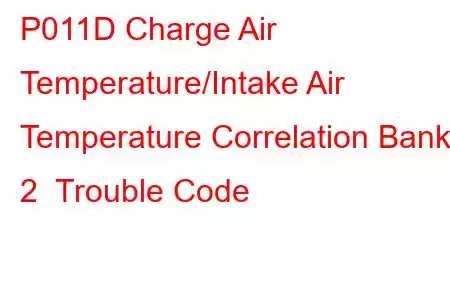P011D Charge / Intake Air Temp Correlation Bank 2
OBD-II Trouble Code Technical Description
Charge Air Temperature/Intake Air Temperature Correlation Bank 2
What does that mean?
This generic powertrain diagnostic trouble code (DTC) typically applies to all OBD-II vehicles. That may include but is not limited to vehicles from Nissan, Toyota, Chevrolet, GMC, Ford, Dodge, Vauxhall, etc. Although generic, the exact repair steps may vary depending on make/model.
A stored code P011D means that the powertrain control module (PCM) has detected a discrepancy in the correlating signals between the charge air temperature (CAT) sensor and the intake air temperature (IAT) sensor for engine bank number two.
Bank 2 refers to the engine bank that does not contain the number one cylinder. As you can probably tell by the code description, this code is used only in vehicles that are equipped with forced air induction devices and multiple intake air inlet sources. Intake air inlet sources are called throttle bodies. Forced air induction devices include turbochargers and superchargers.
CAT sensors are normally composed of a thermal resistor that protrudes from the housing on a wire pedestal. The resistor is positioned so that ambient air entering the engine intake, after leaving the intercooler (sometimes called the air charge cooler), may flow across it. The housing is normally designed to thread or bolt into a turbocharger/supercharger inlet pipe, near the intercooler). As charge air temperature increases, the level of resistance in the CAT resistor decreases; causing circuit voltage to move towards the reference maximum. The PCM sees these variations in CAT sensor voltage as changes in charge air temperature.
The CAT sensor/s provides data to the PCM for boost pressure solenoid operation and boost pressure release valve operation, as well as certain facets of fuel delivery and ignition timing calculation.
The IAT sensor acts in much the same manner as the CAT sensor; in fact, some early (pre OBD-II) computerized vehicle service manuals described the intake air temperature sensor as an air charge temperature sensor. The IAT sensor is positioned so that ambient intake air is drawn across it as it is enters the engine intake. The IAT sensor is located near the air filter housing or air inlet pipe.
A code P011D will be stored and a malfunction indicator lamp (MIL) may be illuminated if the PCM detects voltage signals from the CAT sensor and the IAT sensor which differ by more than a preprogrammed degree. Multiple ignition cycles, with a failure, may be required for MIL illumination.
What is the severity of this DTC?
Overall engine performance and fuel efficiency may be adversely affected by the conditions which contribute to a code P011D being stored, it should be categorized as severe.
What are some of the symptoms of the code?
Symptoms of a P011D trouble code may include:
Decreased engine performance Excessive rich or lean exhaust Delayed engine start-up (especially when cold) Diminished fuel efficiencyWhat are some of the common causes of the code?
Causes for this code may include:
Defective CAT/IAT sensor Open or shorted CAT/IAT sensor wiring or connector Restricted intercooler PCM or PCM programming errorWhat are some P011D diagnostic steps?
I would gain access to diagnostic scanner, a digital volt/ohmmeter (DVOM), and a reliable vehicle information source before attempting to diagnose a code P011D.
Diagnosing any CAT sensor related code, should begin by making sure that there are no obstructions in air flow across the intercooler.
A visual inspection of all CAT/IAT system wiring and connectors is in order if there are no intercooler obstructions and the air filter is relatively clean. Make repairs as required.
Next, I would connect the scanner to the vehicle d
Read: 46


